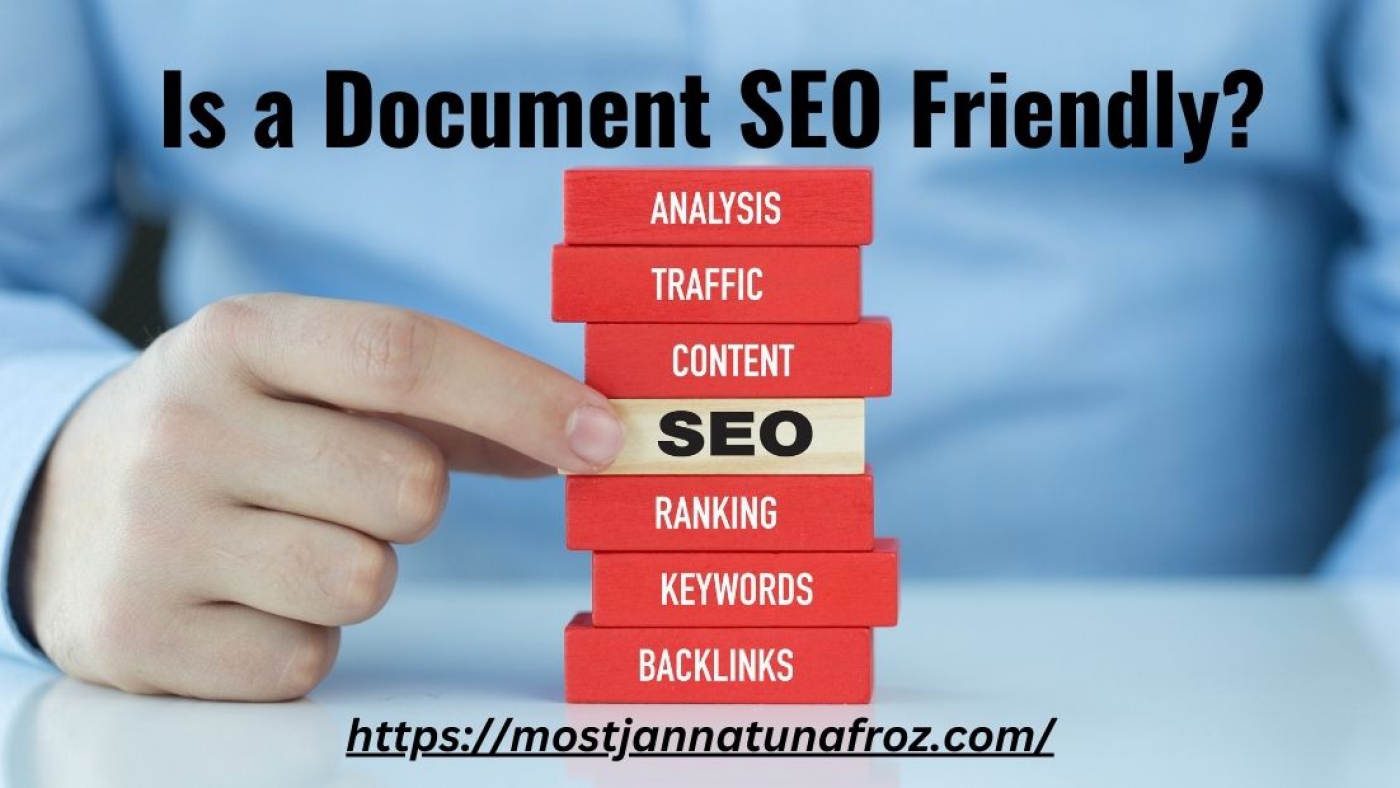In the digital age, creating SEO friendly content is essential for any business or individual aiming to increase their online visibility. Whether it’s a blog post, a PDF, a whitepaper, or a presentation, optimizing your documents for SEO can help you reach a wider audience. But what exactly does it mean for a document to be SEO friendly? And how can you ensure that your documents rank on Google? In this indepth guide, we’ll explore what makes a document SEO friendly and the strategies you can implement to optimize your documents for search engines.
Understanding SEO and Its Importance
Search Engine Optimization (SEO) is improving the visibility of your web content on search engine results pages (SERPs). It involves optimizing keywords, content structure, links, and technical aspects of a document or website to ensure it ranks higher on search engines like Google, Bing, and Yahoo.
Why SEO Matters:
Increases Organic Traffic: SEO helps your content reach a broader audience without the need for paid advertising.
Builds Authority and Credibility: High Ranking documents establish your brand as a trusted authority in your industry.
Improves User Experience: SEO practices often enhance the readability and accessibility of content, providing a better user experience.What Is an SEO Friendly Document?
An SEO friendly document has been optimized to be easily discoverable and readable by search engines. This optimization involves using relevant keywords, structuring content properly, and ensuring the document is accessible. SEO friendly documents are not limited to web pages; they can include PDFs, Word documents, presentations, and other formats.
Examples of SEO Friendly Documents:
- Blog Posts and Articles: Optimized with keywords, meta tags, and proper formatting.
- PDFs: Structured with headings, alt text for images, and keyword usage.
- Presentations: Optimized titles, keywords, and descriptions in slides and file metadata.
Benefits of Making Your Documents SEO Friendly
Optimizing your documents for SEO provides several advantages:
Higher Ranking on Search Engines: Welloptimized documents are more likely to appear on the first page of search results, increasing their visibility.
Increased Traffic and Engagement: SEO friendly documents attract more visitors, leading to higher engagement rates and better lead generation.
Improved Content Accessibility: By following SEO best practices, your documents will be accessible to a broader audience, including those with disabilities.
Enhanced Brand Authority: High Ranking documents help build trust and credibility with your audience.
Key Elements of an SEO Friendly Document
To ensure your document is SEO friendly, focus on these key elements:
a. Keyword Research and Implementation
Identify Primary and LSI Keywords: Conduct keyword research using tools like Ahrefs, Semrush, or Google Keyword Planner. Choose keywords relevant to your document’s content and audience.
By optimizing keyword placement, you can take control of your document’s visibility and relevance. Optimize Keyword Placement: Include primary keywords in the document title, headings, subheadings, and throughout the content. Employ keywords with Latent Semantic Indexing (LSI) to improve relevancy.Employ keywords with Latent Semantic Indexing (LSI) to improve relevancy.
Remember, avoiding keyword stuffing is crucial to maintaining a natural flow in your content. Search engines may penalize you for using too many keywords. Avoid Keyword Stuffing: Maintain a natural flow in the content.Search engines may penalize you for using too many keywords..
b. Title Tags and Headings (H1, H2, H3)
Use a Compelling Title: Include your primary keyword in the title. Make it engaging to encourage clicks.
Structure with Headings: Organize the document using heading tags (H1 for the main title, H2 for subsections, and H3 for subpoints). This improves readability and helps search engines understand the content hierarchy.
Meta Descriptions: Write a concise and informative meta description (150160 characters) that includes your primary keyword.Click Through rates are impacted by this, which shows up in search results.
c. Meta Descriptions and Alt Text
Alt Text for Images: Ensure that all images in your document have descriptive alt text, which helps search engines index visual content.
d. Internal and External Linking
Internal Links: Link to other relevant pages or documents on your site to enhance navigation and SEO value.
External Links: Include links to high authority sites to provide additional resources and build credibility.
e. Readability and User Experience
Use Simple Language: Aim for clarity and simplicity to make the document accessible to a wide audience.
Short Paragraphs and Bullet Points: Break down information into smaller, digestible parts for better readability.
MobileFriendly Design: Ensure your document is easily viewable on mobile devices, as many users access content through smartphones.
How to Optimize Different Types of Documents for SEO
Different document types require specific SEO strategies. Here’s how to optimize various document formats:
a. PDF Documents
Optimize File Names: Use descriptive, keyword rich file names (e.g., “SEOFriendlyDocumentGuide.pdf”).
Text Optimization: Ensure the text in your PDF is searchable and not embedded as an image.
Meta Tags and Alt Text: Include meta information and alt text for images to improve SEO.
b. Microsoft Word Documents
Use Headings and Subheadings: Structure your content properly using heading styles (H1, H2, H3).
Keyword Placement: Incorporate keywords naturally within the document’s content.
File Properties: Edit file properties such as title, author, and keywords to align with SEO best practices.
c. Presentations (e.g., PowerPoint)
Optimize Slide Titles: Use keyword rich titles for each slide.
Alt Text for Visuals: Add alt text to images and charts to make them accessible and improve SEO.
Export to PDF: Convert presentations to PDF format and optimize the file name and meta information.
Tools for Optimizing Documents for SEO
There are several tools available to help you optimize documents for SEO:
- Ahrefs and Semrush: Great for conducting keyword research and tracking rankings.
- Google Analytics: Monitors how users interact with your documents and tracks engagement metrics.
- Adobe Acrobat Pro: Allows you to add metadata and alt text and optimize PDFs for SEO.
- Grammarly and Hemingway: Improve the readability of your content by offering suggestions for clarity and simplicity.
Common Mistakes to Avoid
Even with the best intentions, it’s easy to make mistakes when optimizing documents for SEO. Here are some common pitfalls:
- Keyword Stuffing: Overusing keywords can make the content unnatural and lead to search engine penalties.
- Ignoring Metadata: Failing to include title tags, meta descriptions, and alt text can reduce your document’s visibility.
- Poor Formatting: Neglecting proper structure, such as using headings and bullet points, makes it difficult for search engines and users to understand your content.
- Overlooking Mobile Optimization: Ensure that your documents are accessible on all devices, especially mobile.
Monitoring Document SEO Performance
Once you’ve optimized your documents, monitoring their performance is important to see if your efforts are paying off. Use tools like Google Search Console and Google Analytics to track:
- Traffic: Monitor the number of visitors accessing your document through organic search.
- Engagement Metrics: Check metrics like bounce rate, average time spent on the page, and conversions.
- Keyword Rankings: Track how your document ranks for targeted keywords and adjust your strategy as needed.
Future Trends in Document SEO
The world of SEO is constantly evolving, and it’s essential to stay ahead of emerging trends to maintain and improve your rankings. Consider the following upcoming trends:
- Voice Search Optimization: As voice search becomes more popular, optimizing documents for voice queries will be crucial. Give natural language and longtail keywords priority.
- AI and Semantic Search: Search engines are increasingly using AI to understand the context and intent behind content. Incorporate related terms (LSI keywords) and focus on creating comprehensive, valuable content.
- Video Integration: Including video links and multimedia elements within documents can boost engagement and provide additional SEO value.
Conclusion: Making Your Documents SEO friendly
SEO is not limited to websites and blog posts; it extends to every form of digital content, including documents. Making a document SEO friendly requires strategic planning and implementation of best practices, from keyword research to meta optimization and accessibility. By focusing on these aspects, you can increase your document’s visibility, attract more traffic, and ultimately achieve your digital marketing goals.
Quick Recap:
- Understand the importance of SEO and keyword integration in documents.
- Optimize elements like title tags, headings, meta descriptions, and
- Alt text.
- Use Ahrefs, Google Analytics, and Adobe Acrobat to enhance the SEO performance of your documents.
- Monitor performance and adapt your strategy based on data and emerging trends.
By following these steps, you can create documents that are not only informative and engaging but also optimized to rank higher on search engines. Make SEO a priority for all your digital documents, and you’ll see the benefits of increased traffic, engagement, and authority in your niche.


Add a Comment